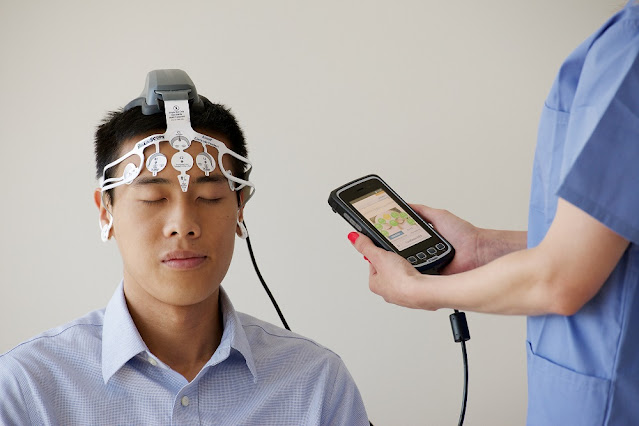Understanding Neurofeedback and its Benefits also known as brainwave biofeedback
 |
| Neurofeedback |
Neurofeedback, also known as brainwave biofeedback, is
a type of biofeedback that focuses on training patients to consciously control
their brain activity. This promising treatment method uses
electroencephalography (EEG) to monitor brainwaves and help patients learn to
control brain activity in areas associated with various conditions. In this
article, we explore what neurofeedback is, how it works, and its potential
benefits.
What is Neurofeedback?
Neurofeedback utilizes real-time displays of brainwave activity to help
individuals understand and adjust their brain rhythms. EEG sensors are placed
on the scalp to record and provide feedback on brainwaves associated with
different states such as relaxation, focus and calmness.
As patients observe changes in EEG indicators like bar graphs or video games,
they learn to control activity in their brains linked to issues like anxiety,
ADHD, insomnia and PTSD. Over sessions, they tune their brain rhythms through a
form of operant conditioning. Neurofeedback does not involve medication or
invasive procedures. Patients play an active role in their treatment as they
train their brains through focused visualization and relaxation.
How Neurofeedback Works
During a typical neurofeedback session, patients sit comfortably as an EEG cap
with sensors is placed non-invasively on their head. The sensors detect
brainwaves across various frequencies like beta, alpha, theta and gamma waves.
EEG signals are amplified and converted to sound or visual feedback, often
presented through computer games or videos.
For example, if someone aims to reduce theta wave activity linked to anxiety,
their theta levels may block a video game from progressing. As the patient
consciously relaxes their mind, theta decreases and the game moves forward as a
reward. Over weekly sessions, patients learn to sustain favorable brainwave
patterns through positive reinforcement. Neurofeedback requires patience and
practice but can help retrain dysfunctional neural networks.
Benefits of Neurofeedback
Research shows Neurofeedback
has promising applications for a
variety of conditions by helping regulate neural functioning. Here are some of
its key potential benefits:
Reduces Anxiety & Stress: Neurofeedback targets the overactive theta waves
linked to anxiety and panic attacks. Studies found it decreased anxiety
symptoms significantly versus control groups.
Improves Focus & ADHD: For ADHD, beta waves are typically under-active
while theta is overactive. Neurofeedback aims to boost beta and inhibit theta
to improve attention and impulse control. Clinical trials found it as effective
as medication.
Enhances Mood & Depression: By regulating abnormal frontal lobe brainwave
patterns tied to depression, neurofeedback may help lift mood and counter
depressive episodes. Small studies indicate potential.
Manages Insomnia: High frontal alpha blocking sleep is targeted. Multiple
studies showed neurofeedback significantly reduced insomnia symptoms and
enhanced sleep quality versus placebo.
Treats Post-Traumatic Stress Disorder (PTSD): Enhancing deficient frontal alpha
and inhibiting overactive theta/beta is a focus. Early research found
neurofeedback reduced PTSD symptoms and enhanced functioning.
Additional Applications: Neurofeedback holds promise based on preliminary
studies for conditions like substance abuse, chronic pain, brain injuries and
more by retraining problematic neural activity. More high-quality research is
still needed.
While neurofeedback shows promise, some drawbacks should be noted:
- Results are variable since response depends on individual brain physiology
and level of commitment to practice.
- Long term effects beyond 6-12 months after completing therapy are unclear
since maintenance training is usually needed.
- Training does not directly target root causes or biochemistry issues in some
conditions.
- Availability of qualified neurofeedback practitioners is limited in many
areas.
- Costs are usually not covered by insurance since its classification is still
unclear. Treatment can be expensive without coverage.
- Optimal protocols are still being developed through research for specific
disorders. Standardization work continues.
- Sample sizes in published clinical studies are often small so more rigorous
research is warranted in many areas.
However, as a non-invasive and low-risk modality, neurofeedback continues
gaining recognition and coverage as research substantiates its benefits for an
array of conditions by regulating dysfunctional brain activity. For those
interested, consulting a certified neurofeedback clinician can help assess
suitability and determine if it may help address specific health complaints.
Get more insights on- Neurofeedback
Check more trending articles related to this topic: Protein Sequencing



Comments
Post a Comment